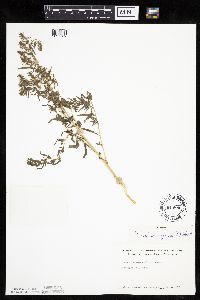Bassia scoparia
|
|
|
|
Family: Amaranthaceae
Mexican-Fireweed, more...burningbush
[Bassia sieversiana (Pallas) W.A. Weber, moreKochia alata Bates, Kochia scoparia (L.) Schrad., Kochia scoparia var. culta Farw., Kochia scoparia var. pubescens Fenzl, Kochia scoparia var. subvillosa Moq., Kochia scoparia var. trichophila (Stapf) Bailey, Kochia scoparia var. trichophylla , Kochia sieversiana (Pallas) C.A. Mey., Kochia trichophila Stapf, Kochia trichophylla Hort.] |
Annual herb to 1 m tall Stem: upright, bushy-branched, ribbed, often hairy above. Leaves: alternate, stalkless, 2 - 5 cm long, 3 - 7 mm wide, linear to narrowly lance-shaped with a rounded or slightly pointed tip, more or less hairy. Inflorescence: a spike of flowers, 5 - 10 cm long, and hairy. Flowers: solitary or paired, in axils of leaf-like bracts, stalkless, greenish, small, with five nearly triangular sepals and no petals. Stamens five, exserted. Stigmas two or three. Fruit: one-seeded (utricle), enclosed in the persistent, incurved sepals, 2.5 mm wide, star-shaped, with a short, horizontal wing on the outer side of each sepal. Wall (pericarp) not adhered to the seed, membranous. Seed horizontal, brownish, 1.5 mm wide, wedge-shaped, flat, slightly ribbed. Similar species: No information at this time. Flowering: late July to early October Habitat and ecology: Introduced from Europe. Very common as a weed in waste ground. It is also common on railroad ballast. Occurence in the Chicago region: non-native Etymology: Kochia is named after Wilhelm Daniel Joseph Koch (1771-1849), a German botanist. Scoparia means "like a broom." Author: The Morton Arboretum Esser 1995, Kearney and Peebles 1969, Undersander et. all 1990, vPlants (Morton Arb), Heil et al 2013 Duration: Annual Nativity: Non-Native Lifeform: Forb/Herb General: Herbaceous annuals, to 1.5 m tall, stems striated, erect and much-branched, herbage somewhat arachnoid with scattered, long hairs. Plants are dark green when young and turn bright red with maturity. Leaves: Alternate, sessile, lanceolate, 2-10 cm long and <1-12 mm wide, acuminate at the tips, margins entire, blades thin and flat. Flowers: Inflorescences are interrupted spikes, both terminal and axial. Flowers are sessile and subtended by leaflike bracts. Flowers greenish, small (1 mm), perfect, with five nearly triangular sepals, no petals, 5 exserted stamens and 2 to 3 stigmas. Fruits: Single seed enclosed in the persistent, incurved sepals. Sepals with a short, horizontal wing on the outer side of each. Wall (pericarp) not adhered to the seed, membranous. Seed horizontal, brownish, 1.5 mm wide, wedge-shaped, flat, slightly ribbed. Ecology: Found on saline or alkaline soils, in fields, pastures, rangelands, and disturbed areas, among sagebrush, desert scrub, chapparal, and pinyon-juniper grasslands and shrublands, from 2,500-10,000 ft (762-3048 m); flowering June-October. Distribution: Native to Eurasia, is an escaped cultivar and widespread in the United States. In the Southwest it is an incredibly common weed in the middle to upper elevations. Notes: This somewhat brushy plant can sometimes form dense stands, is highly drought resistant, and is often found in disturbed and waste areas. Look for this species under Bassia scoparia in older texts. According to Kearney and Peebles, Kochia scoparia is differentiated from the other species of Kochia in Arizona, K. americana, by its annual duration, branching stems, and thin, flat leaves. K. americana is a perennial, has mostly unbranched stems, and leaves which are round in cross-section, sessile and somewhat fleshy. Another similar species, Bassia hyssopifolia, is also an annual but is hairier than K. scoparia and has hooked spines on its outer perianth segments. Look for it in Chenopodiaceae in older texts; that entire family is now considered to be part of Amaranthaceae. Ethnobotany: Plant used for sores. Plant used as sheep forage, especially in the winter. Used by medicine men for painting a patient during a healing ceremony. Etymology: Kochia is named for Wilhelm Daniel Josef Koch (1771-1849), a German doctor and professor of botany, while scoparia means broom-like, alluding to the plant structure. Synonyms: Bassia scoparia, and many others, see Tropicos Editor: LCrumbacher 2012, AHazelton 2015 Bushy-branched, erect annual to 1 m, usually villous above; lvs linear to narrowly lanceolate, sessile, ±pubescent; spikes 5-10 mm, villous; bracteal lvs 3-10 mm; fls solitary or paired; cal at anthesis 0.3 mm long, at maturity 2.5 mm wide, star-shaped, each sep incurved over the fr and bearing a short dorsal wing; styles villous, to 2 mm; seed 1.5 mm wide; 2n=18. Native of Europe, naturalized in w. U.S. and occasionally adventive from the w. or escaped from cult. in our range. Western plants are mostly more villous and have short lvs 1-3 cm with spreading cilia to 2 mm. Cult. and escaped plants, sometimes called var. culta Farw., are less villous or glabrous and have inconspicuously ciliate lvs 3-5 cm; they turn bright red in the autumn. Gleason, Henry A. & Cronquist, Arthur J. 1991. Manual of vascular plants of northeastern United States and adjacent Canada. lxxv + 910 pp. ©The New York Botanical Garden. All rights reserved. Used by permission. From Flora of Indiana (1940) by Charles C. Deam Occasionally found on dumps, sporadic in appearance, but will never become an escape or established in the state. Introduced in America. One specimen seen from Wells County which might be referred to the var. trichophila (Schinz & Thell.) Bailey. This differs from the species by its narrow, linear leaves (1-2 mm wide), by its fastigiate growth, and its bright red color in the autumn. ...... Indiana Coefficient of Conservatism: C = null, non-native Wetland Indicator Status: FACU Diagnostic Traits: stems villous; leaves all alternate; flowers mostly perfect; fruiting calyx with 1+ lobes that end in a spine. |
|
|
|
































































































